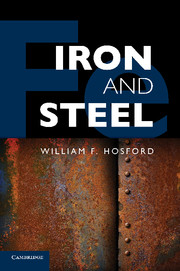Book contents
- Frontmatter
- Contents
- Preface
- 1 General Introduction
- 2 Early History of Iron and Steel
- 3 Modern Steel Making
- 4 Constitution of Carbon Steels
- 5 Plastic Strength
- 6 Annealing
- 7 Deformation Mechanisms and Crystallographic Textures
- 8 Substitutional Solid Solutions
- 9 Interstitial Solid Solutions
- 10 Diffusion
- 11 Strain Aging
- 12 Austenite Transformation
- 13 Hardenability
- 14 Tempering and Surface Hardening
- 15 Low-Carbon Sheet Steel
- 16 Sheet Steel Formability
- 17 Alloy Steels
- 18 Other Steels
- 19 Stainless Steels
- 20 Fracture
- 21 Cast Irons
- 22 Magnetic Behavior of Iron
- 23 Corrosion
- Appendix I Physical Properties of Pure Iron
- Appendix II Approximate Hardness Conversions and Tensile Strengths of Steels
- Index
- References
2 - Early History of Iron and Steel
Published online by Cambridge University Press: 05 May 2012
- Frontmatter
- Contents
- Preface
- 1 General Introduction
- 2 Early History of Iron and Steel
- 3 Modern Steel Making
- 4 Constitution of Carbon Steels
- 5 Plastic Strength
- 6 Annealing
- 7 Deformation Mechanisms and Crystallographic Textures
- 8 Substitutional Solid Solutions
- 9 Interstitial Solid Solutions
- 10 Diffusion
- 11 Strain Aging
- 12 Austenite Transformation
- 13 Hardenability
- 14 Tempering and Surface Hardening
- 15 Low-Carbon Sheet Steel
- 16 Sheet Steel Formability
- 17 Alloy Steels
- 18 Other Steels
- 19 Stainless Steels
- 20 Fracture
- 21 Cast Irons
- 22 Magnetic Behavior of Iron
- 23 Corrosion
- Appendix I Physical Properties of Pure Iron
- Appendix II Approximate Hardness Conversions and Tensile Strengths of Steels
- Index
- References
Summary
Native Iron
The only sources of iron available to early humans were meteoric iron and native (telluric) iron. Both were scarce. Most meteorites are nonmetallic; only about 6% are iron, and these contain about 7 to 15% nickel. In 1808, William Thomson sectioned and etched a meteorite, noting the remarkable patterns. Although he published his findings in 1808, they attracted little interest. Also in 1808, an Austrian, Alois von Widmannstätten, also etched a meteorite and observed the structure that is now known by his name. In 1820, he and Carl von Schreibers published a book on meteorites, which contained a print from a heavily etched meteorite (Figure 2.1). Native iron is even scarcer, being limited to small particles in western Greenland. Archeological finds of iron with considerable amounts of nickel suggest that they were made from meteorites.
The first production of iron dates back to at least 2000 bc in India and Sri Lanka. By 1200 bc, production of iron was widespread in China and the Near East. The most common iron ores are hematite (Fe2O3) and magnetite (Fe3O4). Smelting of iron involved heating iron ore (oxides of iron) with charcoal. The reaction of iron oxide with carbon produced carbon monoxide and carbon dioxide. The air was supplied by either a natural draft or some means of blowing. Early furnaces were of various types. An open-pit furnace is shown in Figure 2.2. The carbon content of iron produced in pit furnaces was usually low because of the low temperatures achieved and resulted in semisolid sponge.
- Type
- Chapter
- Information
- Iron and Steel , pp. 4 - 10Publisher: Cambridge University PressPrint publication year: 2012



